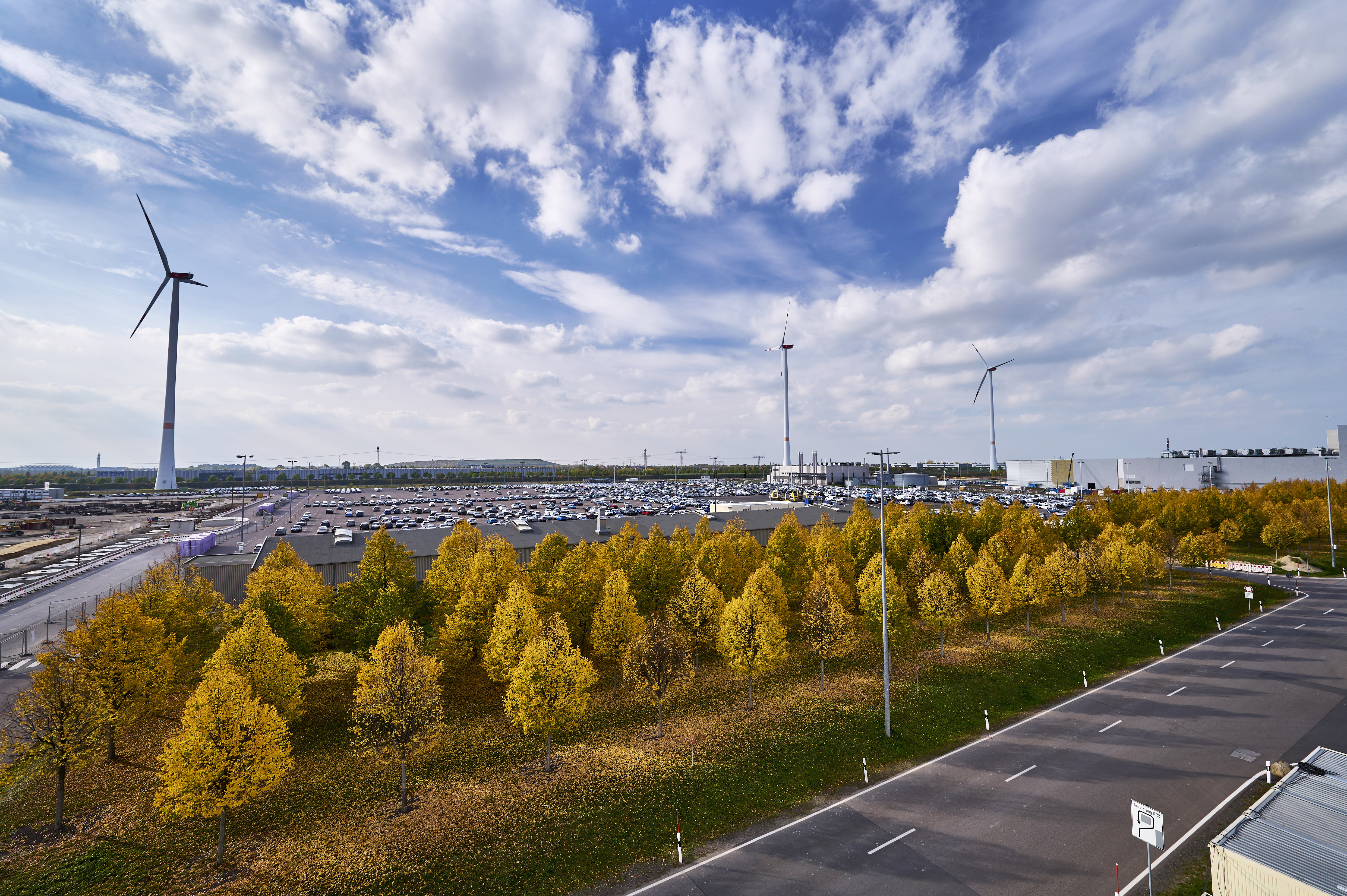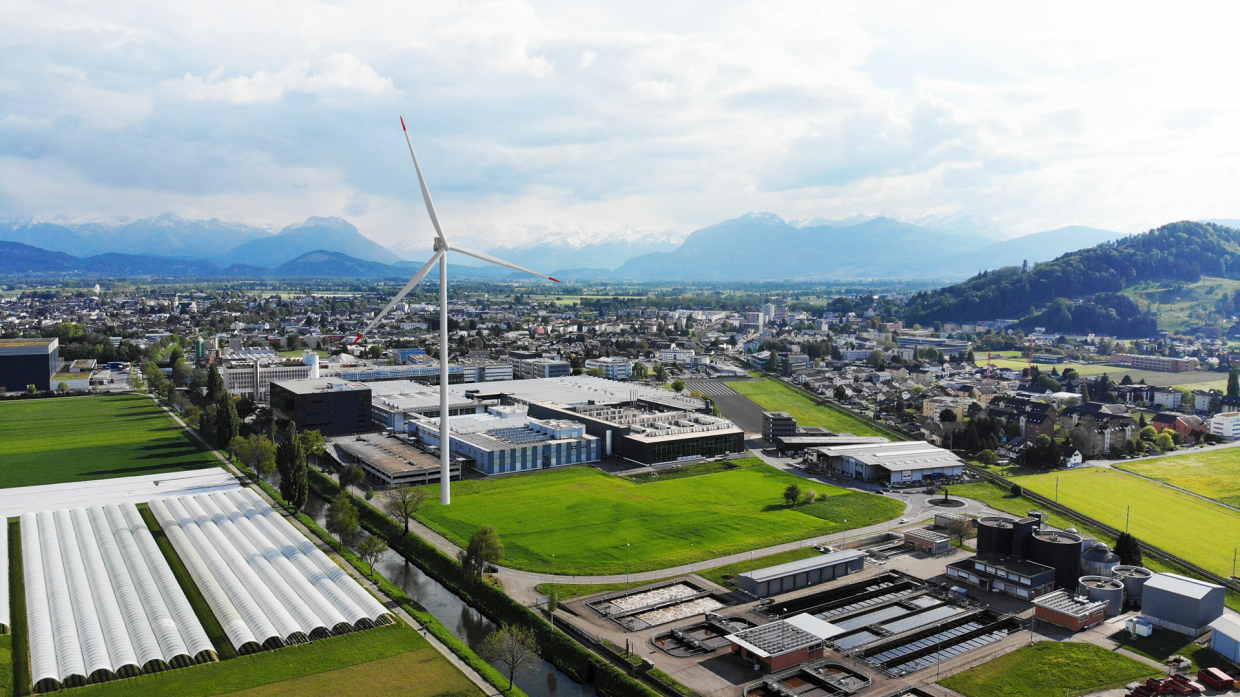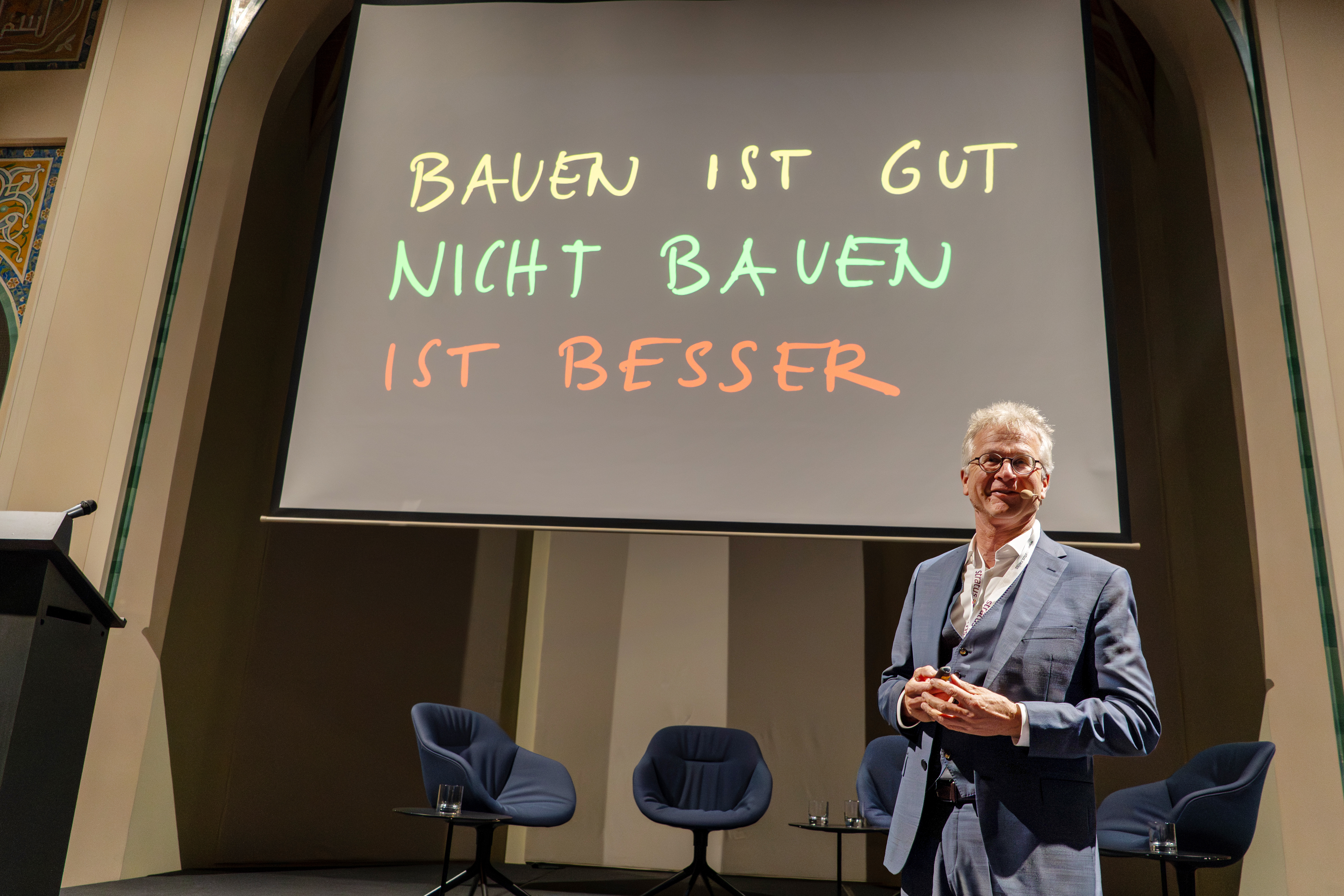Favorable wind for the industry

Swiss industry is called upon to reduce its CO₂ emissions. Current crises have also motivated many industrial and commercial companies to reduce their dependence on the electricity market. At the same time, local energy supplies are looking for ways to expand their share of green electricity in Switzerland. Wind power plants in industrial zones offer a win-win situation.
On June 18, 2023, the municipality of Muttenz in the canton of Baselland said yes to the first large wind turbine in the Basel region. The pioneering project by Primeo Energie is set to produce green electricity for around 800 households in just over five years (1) (2). "The location chosen for the project is special: the wind turbine will not be erected on a greenfield site, but in Muttenzer Hard, an industrial area between the highway and the railway station," says Peter Schwer, senior renewable energy expert at engineering, planning and consulting firm Basler & Hofmann. He and his team created visualizations for the project, prepared the noise report and examined the potential impact of the plant on two objects listed in the Federal Inventory of Swiss Sites of National Importance (ISOS).
Change of scene to Germany: While wind turbines in industrial zones are still a novelty in Switzerland, there are already several successfully implemented projects in other European countries. In the port of Hamburg, for example, the city's energy supply company Hamburg Energie completed six new turbines in 2017. Three are in operation on the site of the Trimet aluminum smelter, while the other three produce electricity at the Arcelor Mittal steelworks. At the beginning of this year, Hamburger Energiewerke announced its intention to drive forward the decarbonization of the port with additional wind power and photovoltaic systems in a joint venture with the Hamburg Port Authority (HPA). The total potential of the project amounts to around 70 megawatts.(3) (4)
"It's a match!" - Wind and industry are a perfect match
Why are industrial zones currently being discovered as new locations for the production of electricity from wind? Industrial areas offer certain advantages for the construction and operation of wind turbines compared to greenfield sites, explains Peter Schwer: "As it is crucial for industry and commerce to be easily accessible, the areas are usually close to existing transport infrastructure such as railroads or highways. In addition, industrial zones are naturally well connected to the electrical Infrastructure. These general conditions simplify the delivery of a new plant and the grid connection. In terms of spatial planning, industrial zones are usually designated in areas with a less valuable landscape. This can facilitate the acceptance of a project by conservation associations.
Green, affordable and sustainable
Whether in cooperation with an energy supply company or on their own, industrial companies benefit from wind on their site in several ways, according to Alexander Kupfahl, Senior Renewable Energy Expert at Basler & Hofmann: "With wind energy, companies can reduce their operationalCO2 emissions and electricity costs. By covering part of their electricity requirements themselves, they are also less dependent on electricity supplies from the market or abroad." Anyone currently building a wind power plant in Switzerland is supported with an investment cost contribution of up to 60%. After the initial investment costs, wind turbines only incur low ongoing operation and maintenance costs. If the wind energy generated can be used directly on site, there are no charges for the use of grid and system services, which now account for a significant proportion of electricity costs. Another advantage for companies is that the costs for their own electricity from wind energy remain stable for around 25 years (the expected service life of a current wind turbine). This is in contrast to the fluctuations in electricity prices on the market. Greater independence from the electricity market also strengthens security of supply. Wind power plants produce two thirds of the electricity in winter, i.e. when there is an increased shortage of electricity on the markets. This makes wind energy an ideal complement to photovoltaics, which generate just 25% of their services in the winter months(5). Last but not least, industry and commerce benefit from the image gain: an investment in wind energy shows that an industrial company is actively committed to climate protection.
Various operating models conceivable
The example in Hamburg shows how a joint venture between energy supply companies and local industry can work. Various forms of collaboration are possible: for example, an industrial company can simply make the site available to the energy supply company. Alternatively, a form of contracting can be agreed, whereby the industrial company makes the site available and purchases a defined amount of electricity each year at fixed conditions. This model is of particular benefit to small and medium-sized industrial companies that do not have the expertise and capacity to manage their own operations in-house. Larger industrial companies are also increasingly taking on projects independently, as the following examples show.
Large industrial companies implement pilot projects
The four wind turbines on the grounds of the BMW Group plant in Leipzig have been supplying the production of the BMW i3 with green electricity from wind energy since 2013. The four turbines produce around 26 gigawatt hours of electricity per year and together cover around a fifth of the plant's total electricity requirements. When production of the electric vehicles is at a standstill, the energy produced is also used in other areas and to cover the base load. The electricity also flows into the BMW "storage farm" on the plant premises. This has been in operation since 2017. It contains up to 700 interconnected BMW i3 high-voltage storage units. Together with the wind turbines, the storage farm links decentralized self-generation from renewable energies with a local energy storage system and a large industrial consumer. Through the additional integration into the public power grid, the storage farm helps to relieve the load on the grid and contribute electricity.(6) If an industrial company produces more electricity with a wind turbine than it can use itself, there are various ways to utilize it, says Alexander Kupfahl: "As the BMW example shows, one solution is to store the electricity locally. Using the electricity to produce green hydrogen can also be interesting for industrial companies. If wind power generation is integrated beyond one company into the supply of the entire industrial area, further synergies can arise. Since the Mantelerlass, it has been possible, among other things, to form a local energy community (LEG). This allows several parties in an industrial estate or neighboring districts to benefit from locally generated electricity."
Back to Switzerland: SFS Group, a leading global manufacturer of application-critical precision components and assemblies, mechanical fastening systems and tools, is planning a wind energy plant at its headquarters in Heerbrugg under the name "RhintlWind" on its own company premises. The planned plant will produce 5 gigawatt hours of electricity per year, which is equivalent to the consumption of around 1,300 households and should cover around 10% of the company's energy requirements in Switzerland. SFS aims to save 2,000 tons ofCO2 annually with the plant (7).

There is technical potential in Switzerland
Of course, not every industrial site is suitable for a wind turbine. However, a simple overlay of the Swiss industrial and commercial zones with the Swiss wind map shows that there is certainly technical potential in Switzerland. From a technical perspective, suitable conditions for the production of wind energy could exist in the foehn valleys, the Rhine valley east of Basel, on the plateaus of the western Jura and at the southern foot of the Jura between Aarau and Lausanne. Narrow valleys, where the wind is more turbulent, and areas that are shaded from the wind by surrounding hills tend to be less favorable. If an industrial or energy supply company is considering a project, a feasibility study is carried out to determine the wind potential and the impact of a plant on the Environmental Engineering and people for the specific industrial site. In addition to the usual clarifications such as noise and shadow impact as well as the occurrence and flight routes of birds and bats, industrial sites also require specific investigations into foundations, contaminated sites and icing, says Peter Schwer: "As industrial areas are usually located in river valleys, the subsoil often consists of gravel or minerals containing clay. In contrast to mountains, this can make pile foundations necessary instead of shallow foundations." Whether a site could have contaminated sites can often be quickly determined by looking at the register of suspected contaminated sites and the history of the industrial area. It is particularly important to analyze the risk of falling ice forming on the rotor blades. "As industrial sites in Switzerland are almost exclusively located in valleys, the probability of ice formation is significantly reduced compared to elevated locations. If there is a certain risk potential, there are now advanced technical systems for ice detection, rotor blade heating or automatic shutdown systems in addition to organizational measures to minimize the risk, such as the targeted guidance of pedestrians and vehicles on the site," says the senior expert.
Opportunity for a sustainable industrial energy supply
With initial projects such as the SFS Group's "RhintlWind" in the Rhine Valley and the planned wind turbine between the highway and the railway station in Muttenz, pioneering work is currently being carried out in Switzerland with regard to the production of wind energy in industrial areas. Ideally covering an entire industrial estate and conceived as an integral part of the local energy supply concept, wind power in industrial zones represents a promising opportunity to make the industrial energy supply more sustainable, efficient and independent.
This article was published in the October 2024 issue of the Electrosuisse Bulletin magazine.
References
(1) Swiss Radio and Television SRF: "Muttenz says yes to the first large wind turbine in the Basel region". SRF News, June 18, 2023: Wind energy vote - Muttenz says yes to the first large wind turbine in the Basel region - News - SRF
(2) V. Sammain, Redact Kommunikation AG: "A wind turbine for Muttenz and the region". Megawatt, the customer magazine of Primeo Energie, issue 02 | 2023, October 2023.
(3) hamburg.de: "Windstrom - auch bei Flaute", accessed on August 20, 2024: Windstrom - auch bei Flaute (hamburg.de)
(4) Hamburger Energiewerke: "Windstrom aus dem Hafen für den Hafen", January 10, 2024: Joint venture between Hamburger Energiewerke and HPA for renewable energy - Hamburger Energiewerke (hamburger-energiewerke.de)
(5) Suisse Éole: "Schweizer Windenergie ist systemrelevant", accessed on August 20, 2024: Wind energy is system-relevant - Suisse Eole (suisse-eole.ch)
(6) K. Lichte, BMW Group: "Die Windräder im BMW Group Werk Leipzig werden in der Adventszeit zu Windkerzen", press release dated December 18, 2020: The wind turbines at the BMW Group plant in Leipzig will become wind candles during the Advent season.
(7) SFS Group, RhintlWind project website, accessed on August 20, 2024: Rheintaler Windrad | Rheintaler Windrad (rhintlwind.ch )



